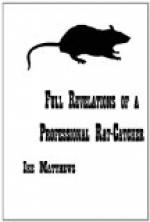Another disease in ferrets, especially young ones, is what I call “red mange.” This starts always under the belly, and you will find that the skin becomes very red and speckled. This is easily remedied by the simple process of washing in lukewarm water and rubbing with sweet oil and black sulphur. The same mixture will answer for “foot rot” if rubbed well into the paws. The general cause of this latter disease is neglect of the ferrets and the hutches not being cleaned out regularly.
I think the best bedding for ferrets is good oat straw, fresh every fortnight. Throw the straw in carelessly, and the ferrets will make their own beds. When breeding ferrets, never go near them more than you can help, as they are of a wild nature and liable to destroy their young. When you know a Jill or bitch ferret has young, give her a little extra good food, but don’t interfere with the young ones on any account, and if you want to give her a little extra bedding put the straw in the same place as the food, and she will take it into the sleeping place herself. It is advisable not to touch the young ones for five weeks, or better still leave them until they come out to feed themselves; and when running about, if there be a good number, say nine or ten, in the lot, it is a good plan to remove them into a larger place for sleeping, as young ferrets are very liable to catch the red mange, which arises from too many being together and sweating very much.
WHEN WORKING FERRETS FOR RAT-CATCHING
always work them unmuzzled. Make as little noise as possible, as Rats are very bad to bolt sometimes. Never grab at the ferret as it leaves the hole, nor tempt it out of the hole with a dead Rat. The best way is to let the ferret come out of its own choice, and then pick it up very quietly, for if you grab at it, it is likely to become what we call a “stopper;” and never on any account force a ferret to go into a hole.
WHEN WORKING FERRETS FOR RABBIT-SHOOTING
always muzzle them. The old-fashioned style of muzzle is, I think, the best, that is, made with string. I don’t approve of wire muzzles, as they are liable to catch against tree roots and bits of sharp stones, and from experience I find the ferret works much better with the string muzzle.




